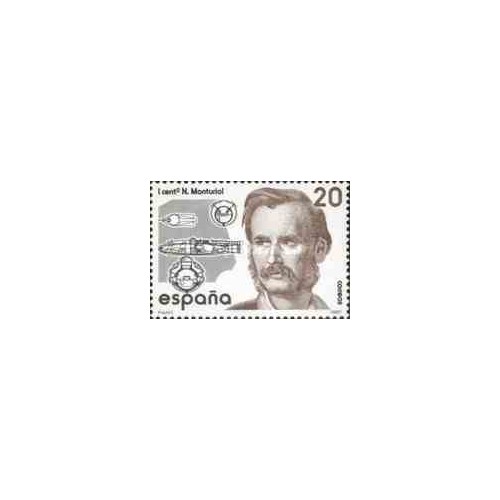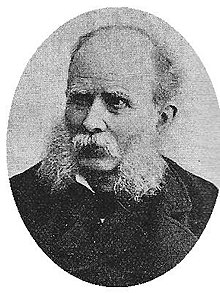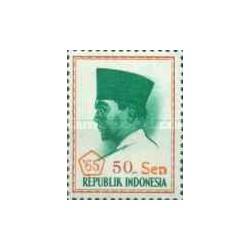- جدید
- ناموجود



توجه : درج کد پستی و شماره تلفن همراه و ثابت جهت ارسال مرسوله الزامیست .
توجه:حداقل ارزش بسته سفارش شده بدون هزینه پستی می بایست 180000 ریال باشد .
توجه : جهت برخورداری از مزایای در نظر گرفته شده برای مشتریان لطفا ثبت نام نمائید.
| Narcís Monturiol | |
|---|---|

Narcís Monturiol around 1880
|
|
| Born | September 28, 1819 Figueres |
| Died | September 6, 1885 (aged 65) Sant Martí de Provençals (currently Barcelona) |
| Occupation | Inventor, engineer, artist, politician |
| Known for | Submarine pioneer. Invented the Ictineo I and Ictineo II. |
Narcís Monturiol i Estarriol (Catalan pronunciation: [nərˈsiz muntuɾiˈɔɫ i əstəriˈɔɫ]; 28 September 1819 – 6 September 1885) was a Spanish intellectual, artist and engineer. He was the inventor of the first air-independent and combustion-engine-driven submarine.
Monturiol i Estarriol was born in the city of Figueres, Catalonia, Spain. He was the son of a cooper. Monturiol went to high school in Cervera and got a law degree in Barcelona in 1845. He solved the fundamental problems of underwater navigation. In effect, Monturiol invented the first fully functional engine-driven submarine.[1][2]
Monturiol never practiced law, instead turning his talents to writing and publishing, setting up a publishing company in 1846, the same year he married his wife Emilia. He produced a series of journals and pamphlets espousing his radical beliefs in feminism, pacifism, and utopian communism. He also founded the newspaper La Madre de Familia, in which he promised "to defend women from the tyranny of men" and La Fraternidad, Spain's first communist newspaper.
Monturiol's friendship with Abdó Terrades led him to join the Republican Party and his circle of friends included such names as musician Josep Anselm Clavé, and engineer and reformist Ildefons Cerdà. Monturiol also became an enthusiastic follower of the utopian thinker and socialist Étienne Cabet; he popularised Cabet's ideas through La Fraternidad and produced a Spanish translation of his novel Voyage en Icarie. A circle formed round La Fraternidad raised enough money for one of them to travel to Cabet's utopian community, Icaria.
Following the revolutions of 1848, one of his publications was suppressed by the government and he was forced into a brief exile in France. When he returned to Barcelona in 1849, the government curtailed his publishing activities, and he turned his attention to science and engineering instead.
A stay in Cadaqués allowed him to observe the dangerous job of coral harvesters where he even witnessed the death of a man who drowned while performing this job. This prompted him to think of submarine navigation and in September 1857 he went back to Barcelona and organized the first commercial society in Catalonia and Spain dedicated to the exploration of submarine navigation with the name of Monturiol, Font, Altadill y Cia. and a capital of 10,000 pesetas.
In 1858 Monturiol presented his project in a scientific thesis, titled The Ictineo or fish-ship. The first dive of his first submarine, Ictineo I, took place in September 1859 in the harbour of Barcelona.

Ictineo I was 7 m (23 ft) long with a beam of 2.5 m (8 ft 2 in) and draft of 3.5 m (11 ft). Her intended use was to ease the harvest of coral. It is likely she was inspired by the prototype Brandtaucher of Wilhelm Bauer, completed in 1851, as Monturiol studied all the available science of submersibles. Ictineo's prow was equipped with a set of tools suited to the harvest of coral. During the summer of 1859, Monturiol performed more than 20 dives in Ictineo, with his business partner and shipbuilder as crew. Ictineo I possessed good handling, but her top speed was disappointing, as it was limited by the power of human muscles.
The technical success of this submersible created popular enthusiasm but no support from the government. As a result, Monturiol wrote a "letter to the nation", asking the people of Spain to support his project. The fund raising was a great success, bringing in 300,000 pesetas from the people of Spain and Cuba.
Ictineo I was eventually destroyed by accident in January 1862, after completing some fifty dives, when a cargo vessel ran into her at her berth. With the money obtained from the subscription, the company La Navegación Submarina was formed with the objective of developing Ictineo II.
A modern replica of Ictineo I stands in the garden entrance to the Marine Museum in Barcelona.
تشکر نظر شما نمی تواند ارسال شود
گزارش کردن نظر
گزارش ارسال شد
گزارش شما نمی تواند ارسال شود
بررسی خود را بنویسید
نظر ارسال شد
نظر شما نمی تواند ارسال شود

check_circle
check_circle















